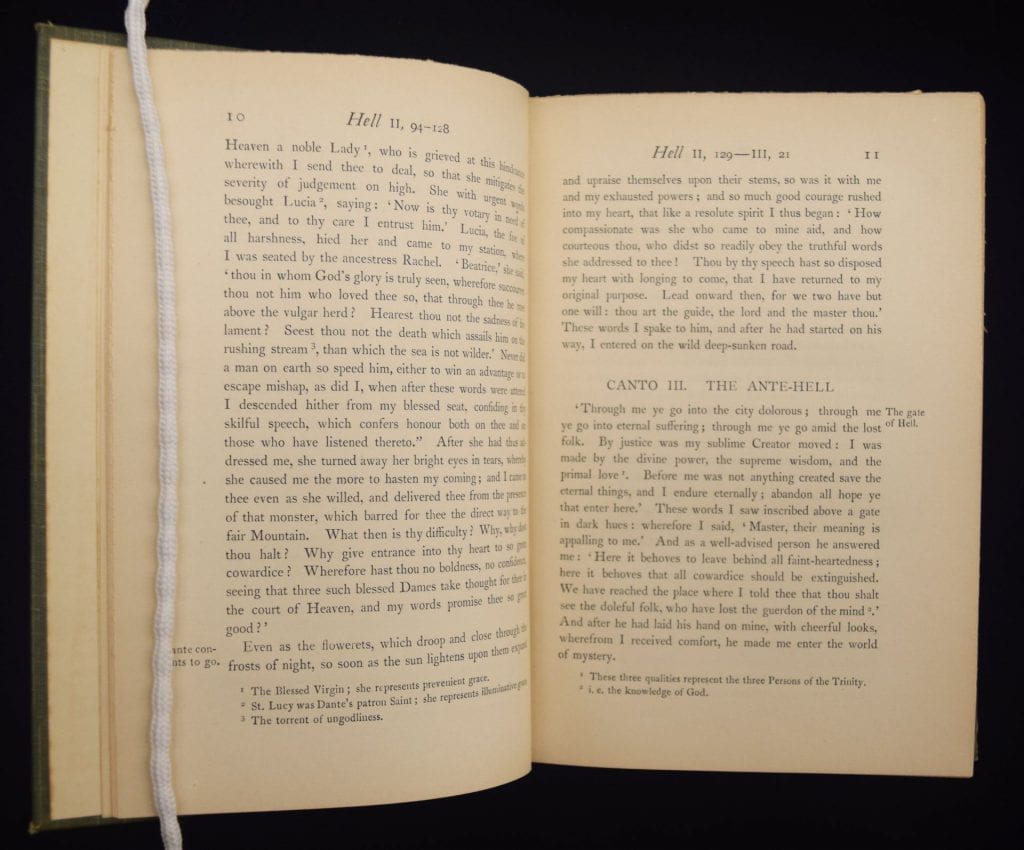Dante’s Divina Commedia, translated into English prose by Rev. H.F. Tozer, Honorary Fellow of Exeter College, Oxford; Fellow of the British Academy; Author of an English Commentary on Dante’s Divina Commedia. Oxford: The Clarendon Press, 1904.
Call number: PQ4315 .T7 1904 (Special Collections)
Case 1: “The Divine Comedy Between Texts and Images”
Even though they are less common than translations in verse, prose translations are available for Dante’s Divine Comedy. This edition includes a few explanatory notes, and it makes reference to the verses of the original poem. As the translator H.F. Tozer writes, this translation renders “the Poet’s meaning as fully and clearly as was in my power without adhering too literally to the words” (p. iii).
Students’ Assignment: Ava, Honey, Pablo
For this assignment, we compared the verse and prose translations of the third canto of Inferno in The Divine Comedy of Dante Alighieri: Inferno, Purgatory, Paradise, translated by Henry F. Cary with complete notes and illustrated by Gustave Doré and Dante’s Divina Commedia, translated into English prose by Rev. H.F. Tozer.
Both translations of the “Comedia” are accurate and effective, but aim to fulfill different purposes. The Divine Comedy of Dante Alighieri translated by Henry F. Cary is written in verse and intends to provide audiences with an emotional and visual picture of the events of the third canto in Inferno. Conversely, Dante’s Divina Commedia translated by H.F. Tozer is written as a narrative and aims to provide audiences with a descriptive and coherent text.
Dante’s Divina Commedia, translated into English prose by Rev. H.F. Tozer, beginning of canto 3
In Dante’s Divina Comedia translated by Tozer (pictured above), the translation provides descriptive accounts of the events of canto 3. The lines read as follows in this publication:
“There sighs, lamentations, and piercing shrieks of woe resounded through the
starless air, so that at first I shed tears there at. Strange tongues, dread utterances,
words of wailing, wrathful tones, cries loud or faint, and the smiting of hands
accompanying them.” (p. 12)
This translation is not meant to be phonetic but conveys the same descriptive language and remains faithful to the original text. It is not as concerned with fancy language or exaggerated events and describes the events as an outside observer, which makes it more narrative.
The Divine Comedy of Dante Alighieri: Inferno, Purgatory, Paradise, translated by Henry F. Cary with complete notes and illustrated by Gustave Doré, beginning of canto 3
We considered the same lines from Canto 3 in The Divine Comedy of Dante Alighieri (pictured above) translated by Cary:
“Here sighs with lamentations and loud moans
Resounded through the air pierced by no star,
That e’en I wept at entering. Various tongues,
Horrible languages, outcries of woe,
Accents of anger, voices deep and hoarse.
With hands together smote that swell’d the sounds.” (p. 18)
This translation is more focused on sound and format than descriptions. The language is what adds to the description of the canto. As such, the text appears to be closest to the original Italian text and poetic intent. Specifically, the narrator is Dante himself, who is experiencing the sights of Hell from a first person point of view.


